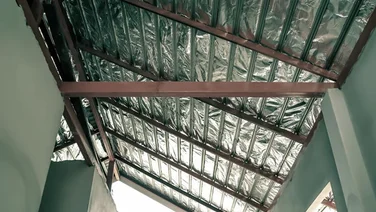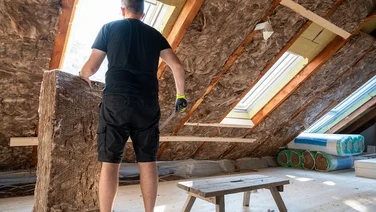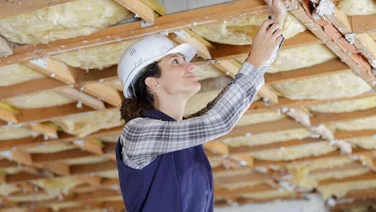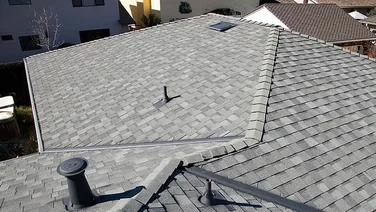- The cost of internal wall insulation is around £60–£100 per square metre
- It costs roughly £7,500 on average to install internal wall insulation
- You could save up to 40% on your heating bills with internal wall insulation

Feeling the chill creep in even with the heating cranked up? Your walls could be the culprit. Here’s where internal wall insulation comes to the rescue.
This guide dives deep into the costs of internal wall insulation, breaking down factors that influence the price and offering estimates for various property types. We’ll explore the average cost per square metre, the impact of material choice and labour, and provide a handy cost range based on the size of your home.
We’ll explore the potential savings on your energy bills, and how quickly you might see a return on your investment.
If you want to find out how much insulation might cost you, fill in our simple form. We’ll put you in touch with our trusted suppliers, who’ll provide you with bespoke quotes for you to compare.
How much does internal wall insulation cost in the UK in 2024?
The cost of a full internal wall installation depends on factors such as materials used, the size of your home, and labour costs. As an estimate, you can expect to pay around £60 to £100 per square metre (m²) for internal wall insulation.
Once installed, internal wall insulation could save you between £180 and £710 each year, or roughly 40% off your heating bill. See below for an estimate based on what type of property you live in:
| Property type | Potential savings |
|---|---|
| Detached | £500–£700 |
| Semi-detached | £290–405 |
| Mid-terrace house | £170–£240 |
| Detached bungalow | £180–£250 |
| Mid-floor flat | £140–£190 |
Internal wall insulation cost per m²
Internal wall insulation costs per m² are around £60–£100, but it depends on how large the property is, the materials used for insulation, and home layout. Below we’ll show the average costs of materials and whether they’re eco-friendly options:
| Material | Aver cost per m² | Eco-friendly |
|---|---|---|
| EPS boards | £9–£11 | No |
| Fibreglass | £9–£11 | Yes |
| Cellulose | £10–£12 | Yes |
| PIR boards | £11–£13 | No |
| Mineral wool | £17–£20 | Yes |
| Cork board | £18–£22 | Yes |
| Sheep wool | £19–£25 | Yes |
| XPS boards | £20–£26 | No |
These are just estimates — you’ll need a professional to get an accurate quote as they’ll need to assess the size of your property.
Keep in mind that with internal wall insulation you’ll need to prepare for workers disrupting your living space and the fact that it’ll shrink the size of the room it’s installed in. While external insulation saves you that space, internal insulation is more cost effective.
Also, be prepared for the installation costs to increase if your property contains intricate architectural features, is much larger, or has any irregular shapes.
Breakdown of internal wall insulation costs
Other than the materials, which make up roughly 40% of the cost of internal wall insulation, there are the labour costs to factor in too, which make up around 60% of what you’ll spend.
For example, a typical three-bedroom property would spend £3,000 on average for the materials, and £4,500 on labour.
A key factor in considering internal wall insulation costs is what type of interior walls you have. You should also consider the size and shape of your walls, and what appliances or electronics will need relocating during installation.
Material costs
When it comes to a complete internal wall insulation, other materials will also be needed for the full install. This will include adhesive and fixings to attach the insulation to the walls physically, which will add to the cost, but not a huge amount.
As an example, primer will cost around £2 per m², and finishing materials will cost roughly £4 per m².
You can see a table of the average cost of materials in the earlier section on internal wall insulation costs per m².
Labour costs
Labour costs could be more intensive for internal wall insulation costs than with external, as you have to factor in whether new walls will be plastered, whether you need to move kitchen or room furniture, and any additional redecorating costs.
Here’s a breakdown of what makes up the cost of labour involved in installing internal wall insulation:
- Typical labour costs per m²
- Size of property differences
- Survey and inspection costs
- Electrical costs
- Redecorating
Surveys and inspections
During a survey a project manager or surveyor will inspect the home to clarify if it qualifies for internal insulation. They will take the homeowner through the process, materials to use, and begin the planning.
Electrical and redecorating costs
When installing internal wall insulation, you might find that there are electric wires that need moving or rewiring completely, which can add additional costs.
On average, rewiring a three-bedroom house completely will cost £6,225 (+VAT), while the average cost of repainting a room will set you back around £400.
When will you break even on internal wall insulation?
You’ll break even on internal wall insulation in just under 22 years (see the chart above). This is assuming a typical three-bedroom property, an average saving of £347 per year, and an installation cost of £7,500.
If energy prices rise, your break-even point will shrink. Considering Ofgem increased the energy cap in October 2024, getting internal wall insulation makes even more sense.
How to reduce internal wall insulation costs?
To help reduce the cost of internal wall insulation, there are zero-interest loans, grants, and schemes available to homeowners in England, Scotland, and Wales.
You can find more information on these government insulation grants to see if you’re eligible to get up to 100% of the costs covered with ECO4, Warmer Homes Scotland, and Nest schemes.
You might also reduce costs with the UK government’s Great British Insulation Scheme.
Next steps
We commend you for considering internal wall insulation as it’s a great way to cut your energy costs and shrink your carbon emissions. That’s good for your wallet and the planet!
Also, you can make your insulation fully sustainable if you use the right materials.
Internal wall insulation is particularly worth it if:
- External wall insulation would damage a property’s character
- You don’t want to pay the much higher price for external wall insulation
It might not be worth getting internal wall insulation if you have a smaller-sized property, as you may lose out on valuable space. External wall insulation might be the better option as you won’t lose out on space.
It’s also probably worth taking extra consideration if you’re planning on doing it yourself without trained professionals, as it could disrupt the integrity of the home’s structure and also introduce moisture and mould/mildew.
If you’re ready to go ahead and insulate your home, we can help. All you need to do is enter a few details about your home in our simple form, and we’ll put you in touch with our expert installers. They’ll get back to you with obligation-free quotes for you to compare.







